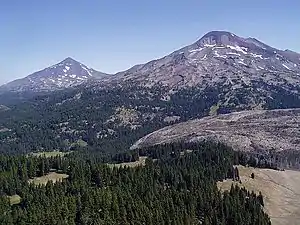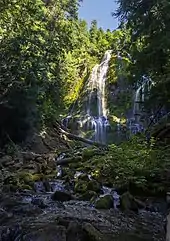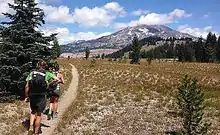| Three Sisters Wilderness | |
|---|---|
 Aerial view of the wilderness, showing Middle Sister (left) and South Sister | |
| Location | Lane / Deschutes counties, Oregon, USA |
| Nearest city | Sisters, OR (20 miles NE) Bend, OR (20 miles E) |
| Coordinates | 44°05′N 121°57′W / 44.083°N 121.950°W |
| Area | 286,708 acres (1,160.27 km2) |
| Established | September 3, 1964 (date of official designation under the Wilderness Act)[1] |
| Governing body | U.S. Forest Service |
The Three Sisters Wilderness is a wilderness area in the Cascade Range, within the Willamette and Deschutes National Forests in Oregon, United States. It comprises 286,708 acres (1,160.27 km2), making it the second largest wilderness area in Oregon, after the Eagle Cap Wilderness. It was established by the United States Congress in 1964 and is named for the Three Sisters volcanoes. The wilderness boundary encloses the Three Sisters as well as Broken Top, which is southeast of South Sister.[2]
Three Sisters was designated as a UNESCO Biosphere Reserve under the Man and the Biosphere Programme in 1976, and was one of 17 reserves in the United States withdrawn from the programme in June 2017.[3][4][5]
Oregon Route 242 separates the Three Sisters Wilderness from the Mount Washington Wilderness to the north, while the Waldo Lake Wilderness shares the southern boundary.[2]
The three peaks were known by pioneers as Faith, Hope and Charity.[6] Nearby landmarks include The Husband, The Wife, and the Little Brother.[7]
Geology
Many types of landforms make up the wilderness area, but the most common are volcanic features, the most notable being the Cascades which are stratovolcanoes having formed around 1.6 million years ago.[8] Numerous cinder cones have formed on their flanks as well as many lava flows that contain hundreds of lava tubes.[9]

Topography
The Three Sisters Wilderness ranges in elevation from 2,000 to 10,363 feet (610 to 3,159 m). The Three Sisters—North Sister at 10,090 feet (3,075 m), Middle Sister at 10,052 feet (3,064 m), and South Sister at 10,363 feet (3,159 m) — are found in the eastern portion of the Wilderness. Including Broken Top—just to the south at 9,175 feet (2,797 m) — there are 14 glaciers offering one of the best examples of the effects of glaciation in the Pacific Northwest. Collier Glacier, between North and Middle Sister, is the largest glacier in Oregon.[2] The headwaters of the Wild and Scenic Whychus Creek (formerly Squaw Creek[10]) emerge in the Wilderness.[2]
Climate
| Climate data for South Sister 44.1007 N, 121.7698 W, Elevation: 9,825 ft (2,995 m) (1991–2020 normals) | |||||||||||||
|---|---|---|---|---|---|---|---|---|---|---|---|---|---|
| Month | Jan | Feb | Mar | Apr | May | Jun | Jul | Aug | Sep | Oct | Nov | Dec | Year |
| Mean daily maximum °F (°C) | 26.5 (−3.1) |
25.8 (−3.4) |
27.0 (−2.8) |
30.5 (−0.8) |
39.2 (4.0) |
46.7 (8.2) |
57.8 (14.3) |
57.8 (14.3) |
52.7 (11.5) |
42.1 (5.6) |
30.3 (−0.9) |
25.5 (−3.6) |
38.5 (3.6) |
| Daily mean °F (°C) | 20.4 (−6.4) |
18.4 (−7.6) |
18.7 (−7.4) |
21.1 (−6.1) |
28.5 (−1.9) |
35.3 (1.8) |
44.7 (7.1) |
44.8 (7.1) |
40.2 (4.6) |
32.0 (0.0) |
23.8 (−4.6) |
19.6 (−6.9) |
29.0 (−1.7) |
| Mean daily minimum °F (°C) | 14.3 (−9.8) |
11.0 (−11.7) |
10.3 (−12.1) |
11.6 (−11.3) |
17.9 (−7.8) |
23.9 (−4.5) |
31.7 (−0.2) |
31.8 (−0.1) |
27.7 (−2.4) |
21.8 (−5.7) |
17.2 (−8.2) |
13.7 (−10.2) |
19.4 (−7.0) |
| Average precipitation inches (mm) | 20.23 (514) |
14.71 (374) |
16.25 (413) |
13.2 (340) |
9.05 (230) |
5.67 (144) |
1.45 (37) |
1.63 (41) |
4.37 (111) |
11.19 (284) |
19.24 (489) |
23.2 (590) |
140.19 (3,567) |
| Source: PRISM Climate Group[11] | |||||||||||||
Vegetation
Forest cover in the Three Sisters Wilderness includes Douglas fir, Pacific silver fir, subalpine fir, mountain hemlock, western hemlock, lodgepole pine and ponderosa pine. A large area of the Wilderness above timberline contains alpine meadows.[12]
Recreation

Popular recreational activities in the Three Sisters Wilderness include camping, hiking, climbing and fishing. South Sister and Middle Sister are not technically difficult climbs, but summiting North Sister requires technical expertise and equipment. More than 260 miles (420 km) of trails cross the wilderness, including 40 miles (64 km) of the Pacific Crest Trail.[12] The 9.8-mile (15.8 km) French Pete Trail and its surrounding old-growth forest, a nationwide political issue in the 1970s, are located on the western edge of the wilderness near Cougar Reservoir.[13]
See also

References
- ↑ Hendee, John C.; Canon Jr., William R.; Marlow, Larry D.; Brockman, C. Frank (1968). "Wilderness Users in the Pacific Northwest - Their Characteristics, Values, and Management Preferences" (PDF). U.S.D.A. Forest Service Research Paper PNW-61. U.S. Forest Service. p. 6. Retrieved January 4, 2016.
- 1 2 3 4 Three Sisters Wilderness - Wilderness.net
- ↑ "Three Sisters". Retrieved 2 September 2018.
- ↑ UNESCO. "Biosphere Reserves: Europe & North America". Retrieved 2 September 2018.
- ↑ "23 new sites added to UNESCO's World Network of Biosphere Reserves". 14 June 2017. Retrieved 2 September 2018.
- ↑ McArthur, Lewis A.; McArthur, Lewis L. (1974) [1928]. Oregon Geographic Names (4th ed.). Portland, Oregon: Oregon Historical Society Press. ISBN 978-0875950389.
- ↑ Friedman, Ralph (1990). In Search of Western Oregon. Caldwell, Idaho: The Caxton Printers, Ltd. p. 694. ISBN 0-87004-332-3.
- ↑ "Geologic Provinces of the United States: Pacific". USGS. Retrieved July 6, 2013.
- ↑ Matt Skeels. "The Caves of Central Oregon". Oregon High Desert Grotto. Retrieved July 6, 2013.
- ↑ "Forest Service Proposes Central Oregon Name Changes". United States Forest Service. August 19, 2005. Archived from the original on August 13, 2007.
- ↑ "PRISM Climate Group, Oregon State University". PRISM Climate Group, Oregon State University. Retrieved September 30, 2023.
To find the table data on the PRISM website, start by clicking Coordinates (under Location); copy Latitude and Longitude figures from top of table; click Zoom to location; click Precipitation, Minimum temp, Mean temp, Maximum temp; click 30-year normals, 1991-2020; click 800m; click Retrieve Time Series button.
- 1 2 Three Sisters Wilderness - Willamette National Forest
- ↑ Sullivan, William L. 100 Hikes in the Central Oregon Cascades (2004 ed.). Eugene, Oregon: Navillus Press. pp. 158–159. ISBN 0-9618152-6-4.
External links
- Three Sisters Wilderness - Willamette National Forest
- Three Sisters Wilderness - Deschutes National Forest
- Wilderness.net Wilderness information
- TopoQuest map of the Three Sisters